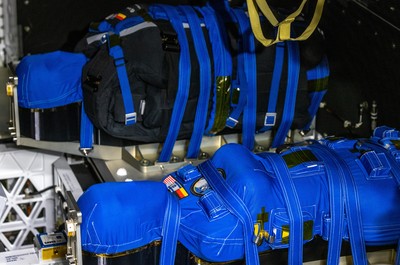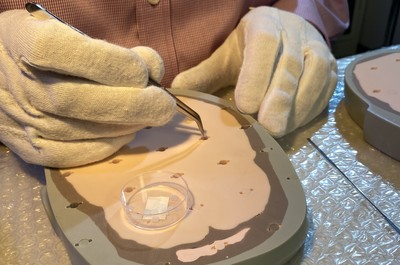Phantoms return from beyond the Moon with valuable data on cosmic radiation doses
8 December 2022
EurekAlert!: [https://www.eurekalert.org/news-releases/973834]

ZOHAR (in protective vest) and HELGA phantoms inside the Orion spacecraft. (Source: NASA / Frank Michaux)
Together with the Orion spacecraft of the Artemis I mission, as part of the MARE experiment, two human phantoms equipped with numerous cosmic rays detectors are to land on Earth. The information gathered by the detectors will for the first time verify the knowledge, crucial for the presence of humans in deep space, of the effects of cosmic rays on the health of the astronauts who are to live and work in an environment devoid of the protective effects of our planet's magnetosphere.
Of the numerous dangers lurking for astronauts undertaking long-distance space travel, among the most serious and at the same time the most difficult to eliminate, is exposure to harmful doses of cosmic radiation. Data collected during the MARE experiment (MATROSHKA AstroRad Radiation Experiment) will help ensure the safety of future deep space pioneers. As part of it, two human phantoms equipped with numerous cosmic radiation detectors were placed aboard the Orion spacecraft of the Artemis I mission. At the invitation of the German Space Centre (DLR) in Cologne, the coordinator of the MARE project, the Institute of Nuclear Physics of the Polish Academy of Sciences (IFJ PAN) in Cracow is participating in the experiment.
“MARE is a continuation of a series of experiments carried out on the International Space Station
between 2004 and 2009 as part of the MATROSHKA project, in which we also participated. Back
then, radiation dose data were necessarily collected in low Earth orbit. Now, thanks to the NASA
Artemis I mission, human phantoms stuffed full of radiation detectors have for the first time gone
beyond the protective range of not only the Earth's atmosphere, but also the magnetosphere
”, says
Prof. Pawel Bilski (IFJ PAN).
Cosmic radiation, to which astronauts journeying at great distances from Earth are to be exposed, is extremely complex in nature. Its galactic component comes from deep space and contains all sorts of naturally occurring particles and atomic nuclei, with a very wide range of energies, often far beyond the values encountered under Earthly conditions. Another source of high-energy particles, this time within our planetary system, are eruptions on the Sun, infrequent, but involving serious risk to the health and even the lives of astronauts. In addition, solar wind particles are continuously accumulating around the Earth within two doughnut-shaped areas of the magnetosphere called the Van Allen belts. Although these belts are located at altitudes of only a few thousand kilometres, they have to be traversed twice during any long-distance crewed expedition.
NASA's main goal during the Artemis I mission was to test the Orion crewed spacecraft in an uncrewed circumlunar flight. The lack of passengers was decided to be exploited to verify current knowledge about the effects of cosmic radiation on the human body. As a result, two female phantoms named HELGA and ZOHAR, each weighing 39 kg, were placed inside Orion. The ZOHAR phantom was dressed in AstroRad protective vest, manufactured by the Israeli company StemRad.
In order to gain information about the doses of cosmic radiation absorbed by various parts of the human body, sets of small, passive lithium fluoride radiation detectors were placed every three centimetres throughout the phantoms. In addition, active silicon detectors were installed at key organ sites. In total, more than ten thousand passive detectors and 34 active detectors were installed in both phantoms.
“Our Institute's contribution to the MARE experiment is primarily 276 passive thermoluminescent
detectors in the ZOHAR phantom and further 288 detectors in 12 measurement packages on the
surface of both phantoms. These detectors are in the form of thin white pellets a few millimetres
in diameter
”, says Prof. Bilski.
The main material used for the production of the detectors from IFJ PAN is lithium fluoride enriched with carefully selected admixtures. These cause additional metastable energy levels to appear in the material. When cosmic ray particles pass through material composed in such a manner, ionization of atoms occurs. Some of the electrons that are knocked out then end up in the metastable levels where they can stay for months, as if in a trap. What is of key significance is that the more cosmic ray particles pass through the detector, the more electrons are trapped.
The radiation dose recorded by the lithium fluoride detector can be read thanks to the phenomenon of thermoluminescence. In the laboratory, individual detectors are gradually heated to temperatures of several hundred degrees Celsius. The energy supplied causes electrons to start jumping out of successive metastable energy traps. Some of them quickly recombine, accompanied by the emission of photons. The result is a glow, known by physicists as thermoluminescence.
“Our lithium fluoride detectors work in such a way that the amount of light emitted when they are
heated is proportional to the dose deposited by cosmic ray particles that have interacted with the
material. The reading of the data is therefore reliable and relatively simple, albeit non-trivial. This is
because different traps in the material have different properties and empty at different temperatures
”,
explains Prof. Bilski.
Measurements within the MARE experiment are primarily intended to verify existing knowledge about the effects of cosmic radiation on the human body. The priority is to reduce the risk to astronauts to a minimum, but the research also has a purely practical dimension. This is because the point is to ensure that overly restrictive safety standards do not limit human activity in deep space.
If the return of the Orion spacecraft of the Artemis I mission is successful, the detectors from the ZOHAR and HELGA phantoms will soon return to IFJ PAN for data reading. Preliminary results on the cosmic radiation doses they recorded will be presented by the international MARE experiment team in the first months of next year.
[PDF]
Contact:
Prof. Paweł Bilski
The Institute of Nuclear Physics, Polish Academy of Sciences
tel.: +48 12 662 8414
email: pawel.bilski@ifj.edu.pl


